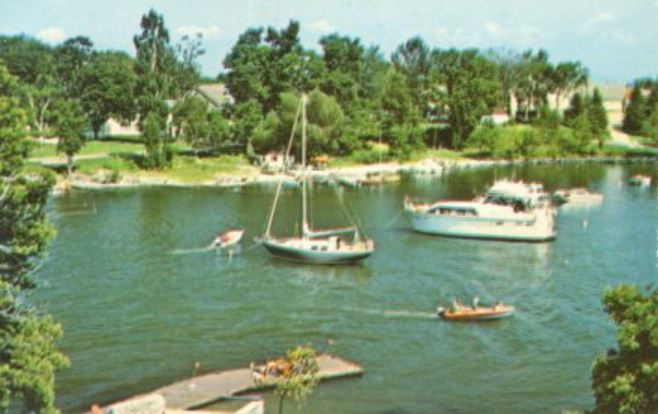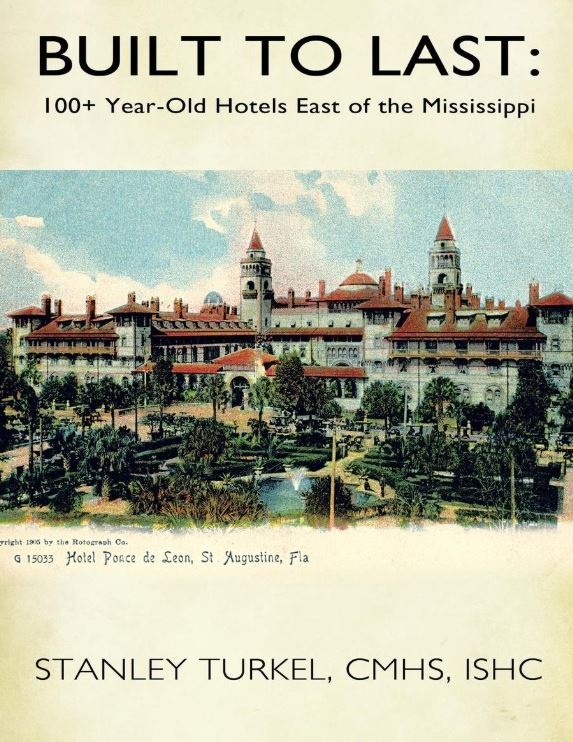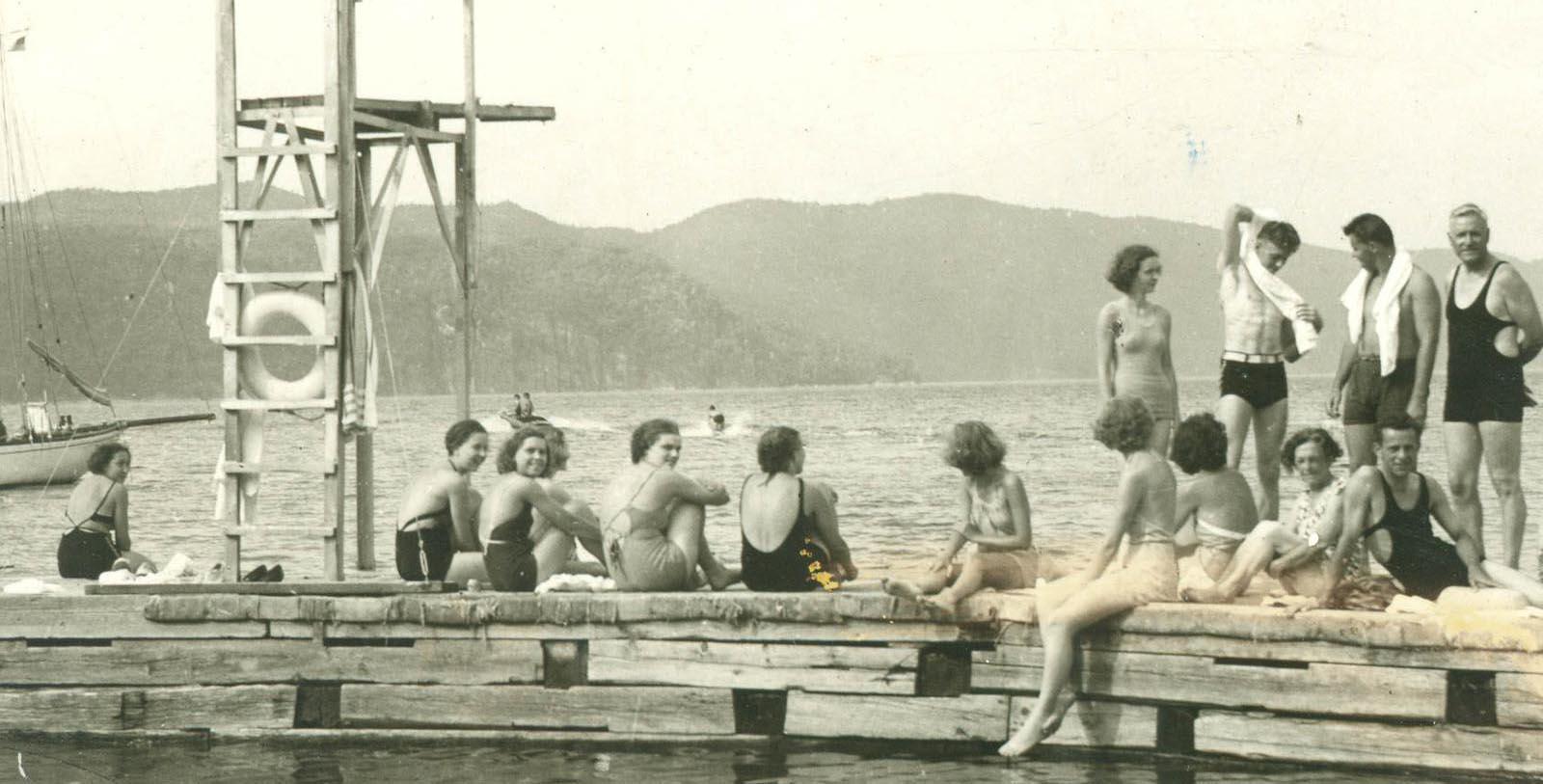Receive for Free - Discover & Explore eNewsletter monthly with advance notice of special offers, packages, and insider savings from 10% - 30% off Best Available Rates at selected hotels.
history
Discover Basin Harbor, which is a historic lodge on the shores of Lake Champlain named for explorer Samuel de Champlain.

Historical Tour of Basin Harbor
Join 4th Generation Host, Bob Beach Jr., as he shares his passion for the land on and around Basin Harbor and Lake Champlain. As stewards of the land, The Beach Family has been a part of this landscape for over 131 years and continue to herald the rich heritage of Basin Harbor.
WATCH NOWUp to the time when Samuel de Champlain followed a group of Algonquin Indians to what is now Lake Champlain, the site of present-day Basin Harbor was uninhabited save for a few scattered Native American tribes. (Interestingly, arrowheads, stone axes, and other artifacts can still be found on the banks of many streams flowing into the lake.) Following the American Revolutionary War, however, soldiers who rendered military service were granted large plots of land in the area as partial pay. A veteran named Platt Rogers subsequently obtained ten acres on the north point of Basin Harbor in 1789. Originally from Fishkill, New York, Rogers had specifically served as a private in two colonial infantry outfits—the 2nd and 6th Duchess County Militia Regiments. Rogers specifically developed a private residence for his family upon the land, as well as a shipyard to service the nascent maritime traffic that had started to occur across Lake Champlain. Incredibly prosperous, his shipyard—commemorated by the stone marker at the resort’s waterfront—became one of the most popular in the whole region. Its successes even outlived Rogers, who passed away just seven years after opening the facility. In fact, a couple of the ships Rogers created were eventually used by the young United States Navy at the Battle of Lake Champlain during the War of 1812. In the wake of Rogers’ death, his personal estate along the lake was divided upon among his various descendants. Only the house and its immediate landholdings went to one of his daughters, who subsequently operated the building as a rustic tavern.
For years, the structure drew business from the local shipping industry, as visiting merchants and sailors often sought refuge inside the building. (In 1823, Lake Champlain was connected to the Hudson River via the Champlain Canal.) Then in 1882, Ardelia Beach fatefully purchased the destination. Under her accomplished stewardship, the location thus began to take on its current, modern appearance. Five generations of the Beach family have subsequently watched over the inn, which gradually transformed into a stunning, world-class facility known as “Basin Harbor.” During the Great Depression, for instance, the Beach family masterfully made Basin Harbor a much-needed retreat for those weary by the ongoing economic hardships. And after World War II, a pent-up impulse for travel exploded across the country and historic Basin Harbor hit its stride. The Beaches thus continued to improve upon the resort’s facilities, taking great leaps, while still holding onto the characteristics that originally drew Ardelia Beach to the landmark location. A member of Historic Hotels of America since 1999, this fantastic secluded resort continues to be one of the best vacation getaways along the storied shores of Lake Champlain. Cultural heritage travelers in particular have thoroughly enjoyed experiencing the resort due to its wonderful historical architecture, fascinating institutional history, and proximity to numerous, nationally renowned landmarks. (Among the popular destination located nearby include Fort Ticonderoga, Shelburne Farms, and the Ethan Allen Homestead Museum.)
-
About the Location +
Located in the city of Vergennes, Basin Harbor resides right next to the majestic Lake Champlain. Named after French explorer Samuel de Champlain—who encountered it in 1609—the body of water itself is rich in history. Indeed, the first people to inhabit its 128-mile-long shoreline were Native Americans of the Iroquois Confederacy, namely the Abenaki and Mohawk. The lake specifically served as an important terminus to the Confederacy’s eastern domain, with the various inlets providing access to both the Hudson and St. Lawrence River valleys. This strategic ability eventually attracted the attention of Great Britain and France throughout the 18th century, which often quarreled over its control. Both sides constructed fortifications all over Lake Champlain, with the most notable being the two French citadels Fort Ticonderoga (then known as “Fort Carillon”) and Fort St. Frederic. The greatest conflict to encapsulate the European struggle over the lake was the North Americans theater of the Seven Years’ War, known today as the “French and Indian War.” Fighting raged across region, as the French gradually worked their way down Lake Champlain from Québec. Capturing the British garrison at Fort William Henry, the French were eventually driven back into Canada in 1759. France would ultimately lose the Seven Years’ War, leaving the contested territory surrounding Lake Champlain firmly in British hands.
Peace was not destined to last, however. Lake Champlain soon became the site for numerous battles between the British and its American colonists, who had begun to settle the region en masse. In fact, some of the first fights of the American Revolution occurred around Lake Champlain, starting with Benedict Arnold and Ethan Allen’s capture of Fort Ticonderoga in 1775. They subsequently turned the British munitions over to Henry Knox, who then sent them east to the Continental Army stationed outside of Boston. The successful surprise attack on Fort Ticonderoga was followed by a frantic naval engagement at a place called “Valcour Bay” a year later. While the American fleet was practically destroyed, the contest nonetheless bought the local American forces enough time to strengthen their defenses throughout the region. The lake would see additional fighting over the course of the war, including British General John Burgoyne’s invasion and subsequent defeat at the Battle of Saratoga. Fortunately, large-scale fighting would drift further south as the revolution progressed, giving the area a respite from constant warfare. Euro-American settlement resumed at a slow pace as such, which gathered energy significantly once the British conceded and recognized the independence of the United States in 1783.
But Anglo-American relations remained tense for many years thereafter. British restrictions on American trade—particularly with Revolutionary France—and territorial friction eventually spawned another conflict called the “War of 1812.” For two years, the British and Americans fought indecisively in a number of theaters—the British managed to defeat another American invasion of Canada, while the United States secured its claim over the Midwest. The British proceeded to mount a counterattack in 1814 though, assaulting the Chesapeake Bay and capturing Washington. At the same time, the British attempted to capture Lake Champlain in an effort to cut New England off from the rest of the country. An American force went north to counter the threat, instigating the Battle of Lake Champlain. The central part of the contest involved a fleet battle, which saw the American squadron completely route the British. Indeed, the bout even saw the destruction of four British ships, as well as the death of their naval commander, Captain George Dowie. (Interestingly, a few American ships used in the fight had actually been constructed at the shipyard formerly owned by Platt Rogers—the first owner of the land that is now home to Basin Harbor.) The American victory had serious ramifications for the outcome of the war. Indeed, the triumph—along with the successful American defense of Baltimore—eventually inspired the British to negotiate an end to the fighting via the Treaty of Ghent.
In the years that followed, Lake Champlain quickly became a site of great economic activity. Industrialists particularly found the area attractive, as the water enabled them to power a group of early factories. The growth expanded the size of several towns throughout the region, too, including Plattsburgh, New York, and Burlington, Vermont. Regional commerce was then augmented more by the debut of the historic Champlain Canal, which connected the lake to the Hudson River. Merchants and sailors subsequently flocked into Lake Champlain like never before, making it one of the most active places in the northeastern United States. But not all of the lake saw the arrival of mass industrialization. Indeed, nearly all of its beautiful coastline remained pastoral for the rest of the 19th century. The preservation of its gorgeous, bucolic landscape inspired many Americans from across New York and New England to observe its beauty. As such, Lake Champlain emerged as a tourist attraction around the start of the 20th century. This desire to visit the lake increased tenfold in the aftermath of World War II. Pent-up demand in the country to travel gave birth to a renaissance for tourist travel to Lake Champlain, making it among the most popular vacation hotspots in the whole country. Lake Champlain has since retained its prestigious reputation as a renowned holiday destination, hosting thousands of people from around the world every year.
-
About the Architecture +
Basin Harbor possesses a unique architectural style that can best be described as “eclectic.” Dating to the mid-19th and early 20th centuries, historians today consider “eclecticism” to be part of a much larger movement to fuse together a variety of historical designs. Earlier in the 1800s, architects—particularly those in Europe—decided to rely upon their own loose interpretations of historical architecture whenever they attempted to replicate it. Such a practice appeared within such styles as Gothic Revival, Italianate, and Second Empire architecture. But at the height of the Gilded Age, those architects decided to use historic architecture more literally when developing a building. A few architects went a step further by combining certain historical styles together to achieve something uniquely beautiful. And in some cases, those individuals felt inspired to add a new historical form onto a building that they were renovating—just like Basin Harbor. Ultimately, the architects felt that joining such architectural forms together would give them a new avenue of expression that they otherwise did not have at the time. They also believed that they had stayed true to the earlier forms, so long as their designs perfectly replicated whatever it was they wanted to mimic.
In Europe, this approach first appeared as a rehash of Gothic Revival-style known as “Collegiate Gothic.” The European architects then used such a mentality to influence the unfolding philosophies of both the Beaux-Arts school of design, as well as the emerging Renaissance Revival-style. Many architects in America followed suit, the most notable of which being Richard Morris Hunt and Charles Follen McKim. The American architects who embraced “eclecticism” were at first interested in the country’s colonial architecture. Much of the desire to return to the time period was born from the revived interest in American culture brought on by the Centennial Exposition of 1876. Pride in preserving the nation’s heritage inspired the architects to perfect the design principles of their colonial forefathers in new and intriguing ways. This interest gradually splintered into other revival styles, though, like Spanish Colonial and Tudor Revival. Some Americans even infused the approach with the popular Beaux-Arts aesthetics of France, such as Hunt and McKim. Yet, the birth of Modernism in the 1920s and 1930s eventually ended the worldwide love affair with “eclecticism,” for architects throughout the West became more enchanted with the ideas of modernity, technology, and progress.


Guest Historian Series
Read Guest Historian SeriesNobody Asked Me, But…
Hotel History: Basin Harbor (1886), Vergennes, Vermont
By Stanley Turkel, CHMS
Following the end of the War of Independence, soldiers were granted large plots of land as partial pay. Platt Rogers bought ten acres from some veterans on the north point of Basin Harbor in 1790 and set up a shipyard and residence. After the war of 1812, a ferry service to New York was commenced. Roger's daughter and son-in-law continued to operate the inn built by Rogers. In 1823, the Champlain Canal opened to connect Lake Champlain with the Hudson River, creating new opportunities for trade on the lake.
In 1882, Ardelia Beach purchased the inn and surrounding land and, in1886, transformed the historic inn into a more modern and expanded facility. Since then four generations of the Beach family have owned and managed the Basin Harbor Club.
In a New York Times column on May 18, 1986, author Grace Hechinger captured the unique qualities of the Basin Harbor Club:
- The scenic 700-acre resort on the shore of Lake Champlain, about 25 miles south of Burlington, Vt., and about 30 miles north of Fort Ticonderoga in New York, is secluded at the end of a long flat road....
Like us, most guests look forward to having the things they like remain unchanged year after year: home baked pastries, Lake Champlain sunsets, the snug privacy of separate cabins, Grandma Beach's apple crisp on the dessert menu every Saturday night. The Basin Harbor Club keeps its old-fashioned charm and adds modern comfort; it's the family estate you would buy if you could afford it....”
Basin Harbor is a family resort, where parents, children and the senior generation finds activities and companions. Last summer there were about 25 family reunions and more than 30 are planned this season. Basin Harbor has been owned and operated by the Beach family for more than a century, ever since Ardelia Beach took in guests on her farm in 1882. The Beaches are wonderful hotelkeepers with an instinctive capability to make guests feel at home: "We make sure there is no waiting in line for dinner or to tee off," says Bob Beach. The Basin Harbor Club consists of more than 700 acres with 77 separate cabins, each of which is different in location, size, amenities, design and name: Sunset, Sundial, Halcycon Whitecaps, etc. All cabins have bathrooms, refrigerators, phones, electric heat, (about half have fireplaces) built-in shelves, porches (some screened in), phones but no television sets.
At Basin Harbor those who want to be busy can play golf or tennis, sail, swim, bike ride, hike, take boat rides of all kinds, water ski, wind surf or go fishing. Every morning at breakfast, a copy of The Basin Harbor Breeze, a one-page newsletter written by Bob's wife, Jane, is on the table. It lists that day's activities and the winners of golf, swimming or tennis matches or a game of bingo.
The surrounding area offers a rich variety of places to visit: Fort Ticonderoga, the Shelburne Museum, Middlebury College, Ausable Chasm, and Stowe as well as the nearby town of Vergennes, the self-proclaimed "smallest city in the U.S.," known during the 19th century as a provider of horse-shoe nails. The Basin Harbor Club operates on the American Plan which includes breakfast, lunch and dinner with comfort food, hot and cold, from crabmeat salad to hot dogs. Desserts, homemade by the pastry chef, are displayed on a separate table: fruit pies, key lime pie, cheesecake, as well as cookies and French pastries. The Club is a member of the Historic Hotels of America and the National Trust for Historic Preservation.
*****
About Stanley Turkel, CMHS
Stanley Turkel is a recognized consultant in the hotel industry. He operates his hotel consulting practice serving as an expert witness in hotel-related cases and providing asset management an and hotel franchising consultation. Prior to forming his hotel consulting firm, Turkel was the Product Line Manager for worldwide Hotel/Motel Operations at the International Telephone & Telegraph Co. overseeing the Sheraton Corporation of America. Before joining IT&T, he was the Resident Manager of the Americana Hotel (1842 Rooms), General Manager of the Drake Hotel (680 Rooms) and General Manager of the Summit Hotel (762 Rooms), all in New York City. He serves as a Friend of the Tisch Center and lectures at the NYU Tisch Center for Hospitality and Tourism. He is certified as a Master Hotel Supplier Emeritus by the Educational Institute of the American Hotel and Lodging Association. He served for eleven years as Chairman of the Board of the Trustees of the City Club of New York and is now the Honorary Chairman.
Stanley Turkel is one of the most widely-published authors in the hospitality field. More than 275 articles on various hotel subjects have been posted in hotel magazines and on the Hotel-Online, Blue MauMau, Hotel News Resource and eTurboNews websites. Two of his hotel books have been promoted, distributed and sold by the American Hotel & Lodging Educational Institute (Great American Hoteliers: Pioneers of the Hotel Industry and Built To Last: 100+ Year-Old Hotels East of the Mississippi). A third hotel book (Built To Last: 100+ Year-Old Hotels in New York) was called "passionate and informative" by the New York Times. Executive Vice President of Historic Hotels of America, Lawrence Horwitz, has even praised one book, Great American Hoteliers Volume 2: Pioneers of the Hotel Industry:
- “If you have ever been in a hotel, as a guest, attended a conference, enjoyed a romantic dinner, celebrated a special occasion, or worked as a hotelier in the front or back of the house, Great American Hoteliers, Volume 2: Pioneers of the Hotel Industry is a must read book. This book is recommended for any business person, entrepreneur, student, or aspiring hotelier. This book is an excellent history book with insights into seventeen of the great innovators and visionaries of the hotel industry and their inspirational stories.”
Turkel was designated as the “2014 Historian of the Year by Historic Hotels of America,” the official program of the National Trust for Historic Preservation. This award is presented to an individual for making a unique contribution in the research and presentation of history and whose work has encouraged a wide discussion, greater understanding and enthusiasm for American History.
Works published by Stanley Turkel include:
- Heroes of the American Reconstruction (2005)
- Great American Hoteliers: Pioneers of the Hotel Industry (2009)
- Built To Last: 100+ Year-Old Hotels in New York (2011)
- Built To Last: 100+ Year-Old Hotels East of the Mississippi (2013)
- Hotel Mavens: Lucius M. Boomer, George C. Boldt and Oscar of the Waldorf (2014)
- Great American Hoteliers Volume 2: Pioneers of the Hotel Industry (2016)
- Built To Last: 100+ Year-Old Hotels West of the Mississippi (2017)
- Hotel Mavens Volume 2: Henry Morrison Flagler, Henry Bradley Plant, Carl Graham Fisher (2018)
- Great American Hotel Architects Volume 1 (2019)
- Hotel Mavens Volume 3: Bob and Larry Tisch, Curt Strand, Ralph Hitz, Cesar Ritz, Raymond Orteig (2020)
Most of these books can be ordered from AuthorHouse—(except Heroes of the American Reconstruction, which can be ordered from McFarland)—by visiting www.stanleyturkel.com, or by clicking on the book’s title.






























